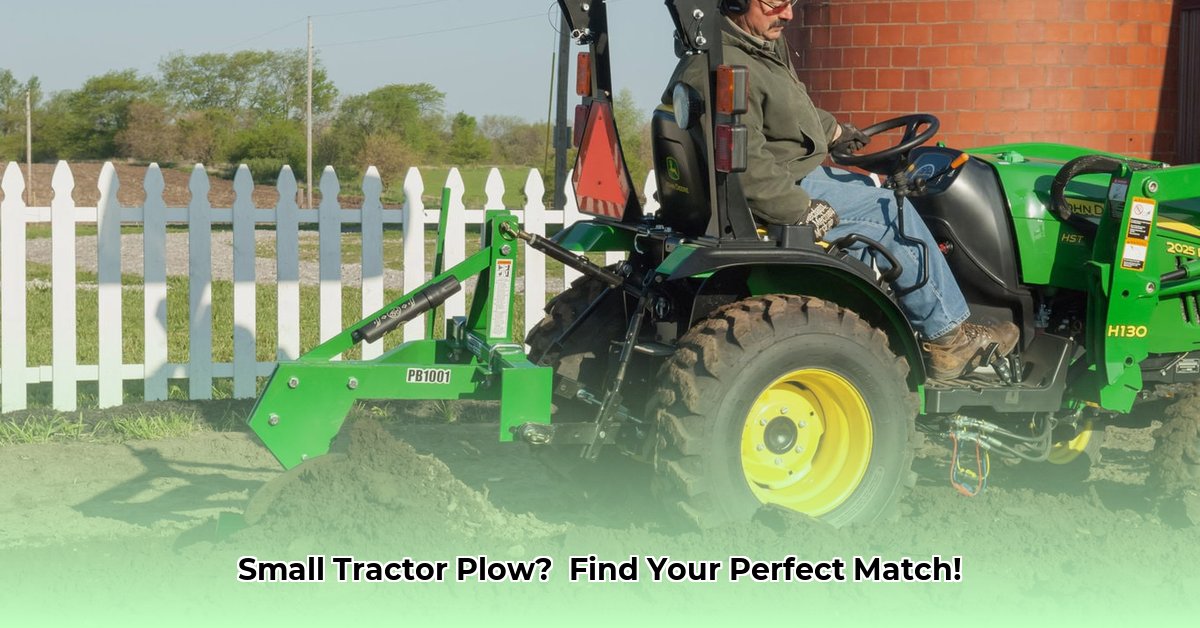
Understanding Your Farming Needs: A Personalized Approach
Before you start shopping for plows, let's assess your specific needs. This will ensure you choose a plow that's both effective and cost-efficient for your operation. Think of it as creating a tailor-made solution for your farm. For smaller tractors, consider options like garden tractor plows.
1. Tractor Specs: What's the horsepower and weight capacity of your tractor? (This information is usually found in your tractor's manual). Exceeding your tractor's capabilities can lead to damage and breakdowns.
2. Acreage: How much land do you need to plow? A smaller plot might only require a lightweight, maneuverable plow. Larger farms often benefit from wider plows that cover more ground per pass, increasing productivity.
3. Soil Type: This is crucial! Sandy soil is easier to till; heavy clay or rocky soil requires a more robust plow capable of cutting through dense, resistant material. Choosing the wrong plow for your soil type can significantly impact your efficiency and even damage your equipment. Do you have any particularly challenging areas on your land?
4. Budget: Set a realistic budget, including not just the initial purchase price but also the ongoing costs of maintenance, repairs, and fuel consumption. A more expensive, high-quality plow might offer longer lifespan and require less frequent maintenance, potentially reducing long-term costs.
5. Tillage Goals: What are you aiming to achieve with your plowing? Are you preparing seedbeds, managing erosion, or improving soil aeration? Your tillage goals will influence the type of plow and the depth of plowing required.
Types of Plows: 3-Point Hitch vs. Quick-Attach
Small tractors typically use two main types of plows: 3-point hitch and quick-attach. Each offers unique advantages and disadvantages.
3-Point Hitch Plows: These are generally heavier-duty plows, known for their robust construction and suitability for challenging soil conditions. They’re ideal for deep plowing and creating well-prepared seedbeds.
- Pros: Durability, precision tillage, excellent for heavy clay or rocky soil.
- Cons: Less versatile – changing implements takes time; not always suitable for small tractors with limited horsepower.
Quick-Attach Plows: Designed for quick and easy changes between implements, making them extremely convenient for farmers who use their tractors for multiple tasks.
- Pros: Versatility, ease of use, speedy switching between implements.
- Cons: Generally lighter-duty construction; less effective on heavy or rocky soil; may not provide the same level of precision in tillage.
Choosing the Right Plow: A Decision-Making Framework
Considering your individual needs (discussed above), here's a step-by-step guide to choosing the right plow:
Match Plow Size to Tractor Capacity: Never exceed your tractor’s recommended weight and horsepower limits. Consult your tractor’s manual for these essential specifications.
Soil Analysis: Assess the type and consistency of your soil. Heavy clay requires a heavier, more robust plow than lighter, sandier soil.
Prioritize Versatility: If you need to use your tractor for multiple tasks, a quick-attach plow offers considerable convenience.
Consider Your Budget: Factor in both the initial cost and long-term maintenance.
Prioritize Sustainability: Choose a plow design that minimizes soil disturbance and fuel consumption, promoting sustainable farming practices.
Installation and Use: A Step-by-Step Guide
The installation process differs slightly depending on the type of plow. Always consult your tractor and plow manuals for precise instructions.
Step 1: Attaching the Plow: Carefully connect the plow to your tractor's 3-point hitch or quick-attach system. Ensure secure attachment to prevent accidents.
Step 2: Setting Depth and Angle: Adjust the plow's depth and angle according to your soil type and tillage goals. Start with shallow passes and gradually increase depth as needed.
Step 3: Plowing Speed: Maintain an appropriate plowing speed. Too fast, and the quality of the tilling will suffer. Too slow, and you’ll waste fuel.
Step 4: Safety Precautions: Always wear appropriate safety gear, including eye protection and sturdy footwear. Be mindful of your surroundings, and avoid operating the plow in unsafe conditions.
Maintenance and Troubleshooting: Keeping Your Plow in Top Shape
Regular maintenance is crucial for the longevity and efficiency of your plow.
- Cleaning: Clean the plow thoroughly after each use to remove mud and debris, preventing corrosion and component damage.
- Lubrication: Lubricate moving parts according to the manufacturer's recommendations.
- Inspection: Regularly inspect for wear and tear, addressing any issues promptly.
- Storage: Store the plow properly to prevent rust and damage.
Conclusion: Sustainable Practices Through Smart Choices
Choosing the right plow is a crucial investment in the long-term health and productivity of your farm. By carefully considering your needs, selecting the appropriate plow type, and adhering to proper installation and maintenance practices, you can ensure efficient and sustainable farming operations for years to come. Remember to research new, more sustainable plow designs and materials as they become available.